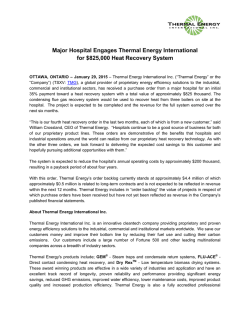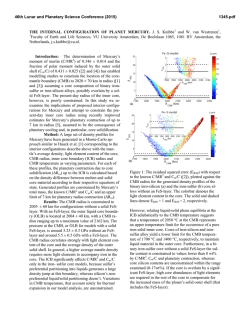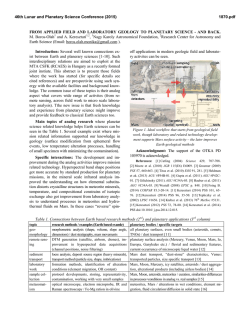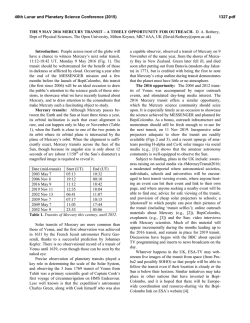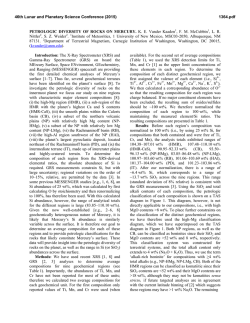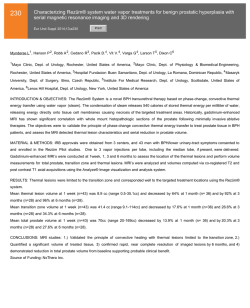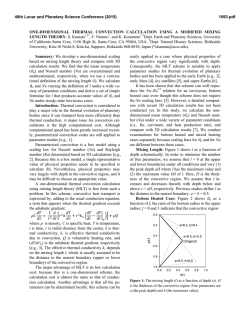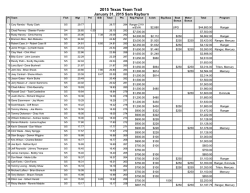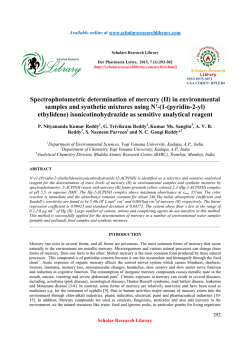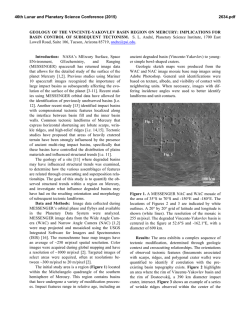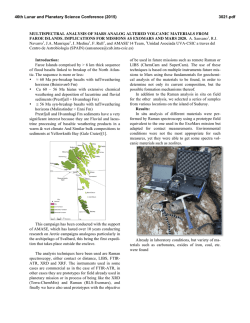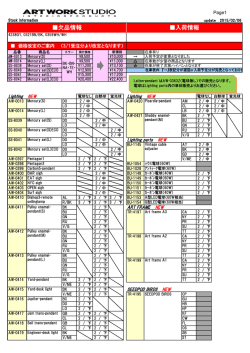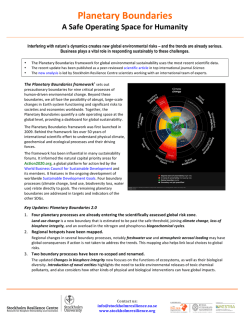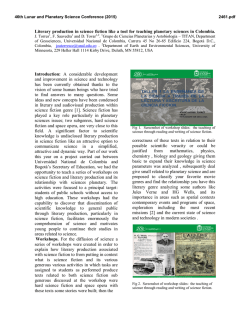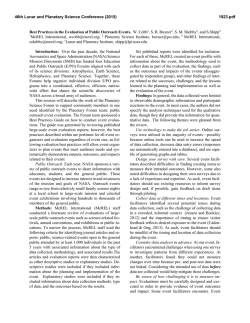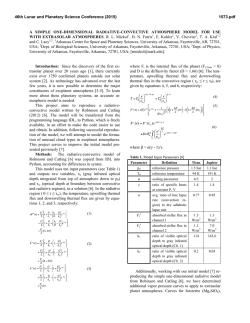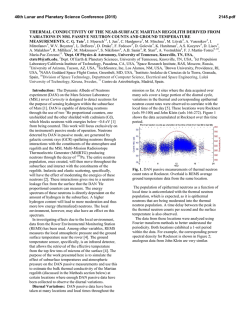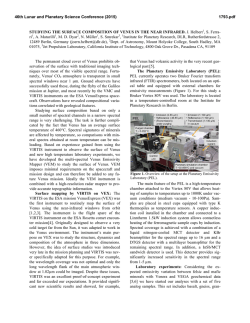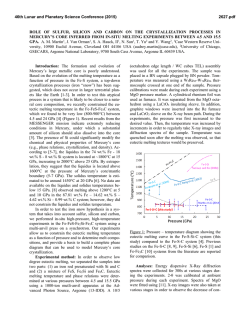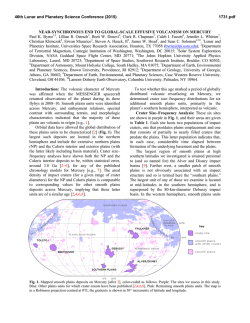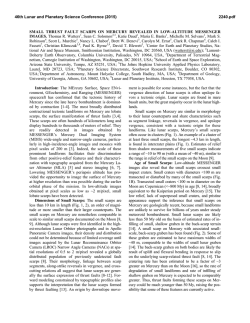
Thermal Infrared Spectroscopy of Igneous Rocks at Simulated
46th Lunar and Planetary Science Conference (2015) 1935.pdf THERMAL INFRARED SPECTROSCOPY OF INGNEOUS ROCKS AT SIMULATED MERCURY’S SURFACE ENVIRONMENT S. Ferrari1, A. Maturilli1, C. Carli2, A. Stojic3, M. D’Amore1, J. Helbert1, H. Hiesinger3, and F. Nestola4, 1Institute for Planetary Research, DLR, Rutherfordstrasse 2, Berlin, Germany ([email protected]), 2IAPS-INAF, via Fosso del Cavaliere 100, Roma, Italy, 3Institute for Planetology, Westfälische Wilhelms-Universität, Wilhelm-Klemm-Str. 10, Münster, Germany, 4Geosciences Department, Università degli Studi di Padova, via Gradenigo 6, Padova, Italy. Introduction: Recent findings by the MErcury Surface, Space ENvironment, GEochemistry, and Ranging (MESSENGER) spacecraft, corroborated by petrologic modeling, revealed the surface composition of Mercury as mainly constituted by low-Fe and Mgrich basalts [1, 2]. This interpretation dismisses the previously assumed widespread presence of more felsic materials - as on the Moon’s surface - leaving open the question of the crust petrogenesis of Mercury. Assessing the presence of a differentiated crust on the surface of Mercury is among the core objectives of the upcoming ESA/JAXA BepiColombo mission to Mercury [3]. The ESA Mercury Planetary Orbiter will carry the Mercury Radiometer and Thermal Imaging Spectrometer (MERTIS) covering the spectral range 714 µm to map the surface mineralogy of the planet at 500 m spatial resolution. The interpretation of spectra collected along a wide range of daily surface temperatures is complicated by the shift of the location of the band minima depending on the temperature [4, 5]. In addition, the simultaneous presence of different minerals, each one with its own characteristic thermal expansion coefficient, results in a more difficult interpretation of the spectra. In this work we examine the thermal infrared (TIR) spectral variations of linear mixtures of plagioclase and pyroxenes that most likely could be present in the differentiated igneous crust of Mercury, in addition to the T-dependent spectral variations of the single constituents. Furthermore we show how two different thermal expansion coefficients combined in the same sample reveal in the resulting thermal infrared spectrum. To this aim we measure high-T emissivity - up to 450° C of synthetic and natural compositions (e.g., anorthosite, gabbro, norite) and their components. Sample Sets and Methodologies: The sample sets includes mixtures, obtained by mixing natural minerals of different origins, and co-genetic mineral compositions occurred in natural bulk rocks. Mineral chemistries are acquired by microprobe analyses, and bulk rock compositions are verified by polarization microscopy and X-ray powder diffraction. Samples are reduced to <125 µm: the selected particle-size class cannot be totally immune to thermal gradient effects and volume scattering in the TIR range, nevertheless it approaches the presumable size of Mercury’s regolith. Mixtures. The objective of this first set of samples is to assess the influence of two different thermal expansion coefficients on a vibrational spectrum, regardless of the different petrologic origin of the selected phases. Natural single-phase crystals are reduced in a jaw crusher and then sieved to <125 µm. Then linear mixtures are obtained, simulating a normalized content of the primary rock-forming minerals. Natural compositions. The second sample set is composed of different mineral phases (plagioclases, clino- and ortho-pyroxenes) separated from the same igneous rock. Each bulk sample is divided into two equal volumes. One portion is mechanically ground toward 2 mm, then the two main rock-forming minerals groups (plagioclase and mafic minerals as pyroxenes, olivines and oxides) are separated by hand-picking. All partitions are further reduced in a jaw crusher and sieved to 63-250 µm sizes, obtaining a grain-size range suitable for a mechanical refinement (Frantz Magnetic Separator, Westfälische Wilhelms-Universität, Münster). Samples considered for TIR measurements include plagioclases and pyroxenes with possible accessory mafic phases (e.g. olivine), all reduced to <125 µm. The second portion of the bulk material is ground and sieved as well to 63-250 µm sizes, then reduced to <125 µm. An example of the achievable sample sets is listed in Table 1. anorthosite mixture natural composition phase 1 phase 2 mixture rock phase 1 phase 2 pl100 pl0 pl90 plx pl100 pl100-x Table 1: Samples representative of an anorthositic composition obtained combining non-co-genetic and co-genetic minerals. The produced particulates are placed into stainless steel cups, with a 50 mm internal diameter, 5 mm thick bottom and 20 mm in height, filling the cups for the first 3 mm. The cups are at last placed in a dryer chamber. TIR spectroscopy. The spectral measurements are performed at the Planetary Emissivity Laboratory (In- 46th Lunar and Planetary Science Conference (2015) stitute of Planetary Research, Deutsches Zentrum fuer Luft- und Raumfahrt, Berlin) [6]. The instrument used is a Bruker Vertex 80V, with a liquid nitrogen cooled HgCdTe detector and a KBr beamsplitter. The spectrometer is coupled to an evacuated planetary simulation chamber, where the steel sample cups are heated via an induction system [4]. Samples are heated once and emissivity are collected under a pressure of 1 mbar at 150°C, 250°C, 350°C and 450°C with increasing temperatures, then during the cooling maintaining the temperature at 250°C. Radiance is collected by an Au-coated parabolic 90° off-axis mirror and reflected to the spectrometer, which acquires spectra between 10000 and 615 cm-1 at a resolution of 4 cm−1. Measurements of the calibration body are taken at the same temperatures as the sample. Within the chamber, an iron buffer is provided in order to avoid any possible Fe oxidation during the annealing (Fig.1). Besides spectroscopy, all the provided samples are analyzed before and after the heat-treatment using XRay Diffraction, in order to verify any possible variation due to the annealing. Figure 1: Sample is placed within the chamber; the temperatures of the radiative surface, the chamber walls and the mirror are constantly monitored; the iron buffer is placed in the proximity of the sample. The objectives of this specific set-up are (i) preventing any possible variation of the sample during the heating, (ii) reaching the maximum temperature variation achievable by the PEL set-up within the range suggested for the surface of Mercury, (ii) verifying any possible variation occurred during the entire experiment. Results: Here we show a first example of anorthosite. Spectra of (i) a mixture constituted by 90 wt.% of Ca-rich plagioclase (labradorite) and 10 wt.% of Mgrich clinopyroxene (augite) and (ii) a reduced anor- 1935.pdf thositic rock sample are collected under the same conditions. Compared to the lower-temperature (i.e. 150°C) labradorite spectrum, the lower-temperature mixture spectrum shows a slight flattening and a shift of the first reststrahlen band towards lower wavenumbers, assimilating the contribution of the Mg-rich clinopyroxene (augite) emissivity. With increasing temperature, sample spectra tend to increase the band depths, and shift the minima with different magnitude to lower wavenumbers (Fig. 2). The absorptions in the 900-1200 cm-1 region, which are due to Si-O stretch motions of the silica tetrahedra in the structure, display the most significant shifts. A preliminary comparison between the synthetic anorthosite and a natural one confirms the same trend for the main absorption bands (Fig. 2). Figure 2: Changes in the position of the first absorption band as a function of temperature for the mixture (full squares, 1124 cm-1 position for 1-R room-temperature minimum) and the natural anorthositic sample (empty squares). Further observations include the shift of the Christiansen feature (CF) toward higher wavenumbers, the increase of depth for most of the bands relative to the continuum removal, and the stasis or disappearance of bands located in the 600-900 cm-1 range with increasing temperatures. References: [1] Nittler L. R. et al. (2011) Science, 333, 1847– 1850. [2] Stockstill-Cahill. et al. (2012) J. Geophys. Res., 117, E00L15. [3] Benkhoff J. et al. (2010) PSS, 58, 2-20. [4] Helbert J. et al. (2013) EPSL, 371-372, 252-257. [5] Ferrari et al. (2014) Am. Min., 99, 786792. [6] Maturilli A. et al. (2008) PSS, 56, 420-425.
© Copyright 2024
